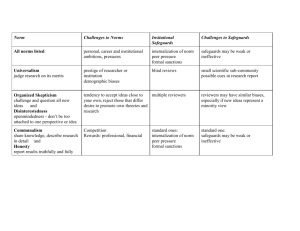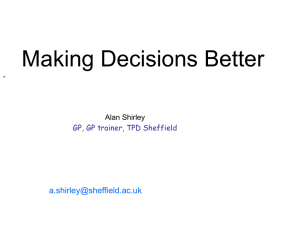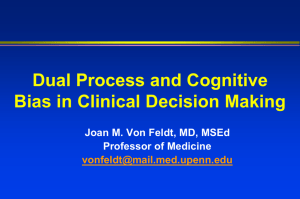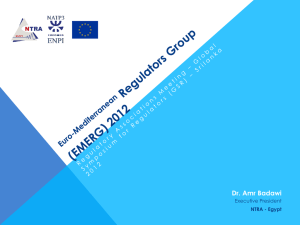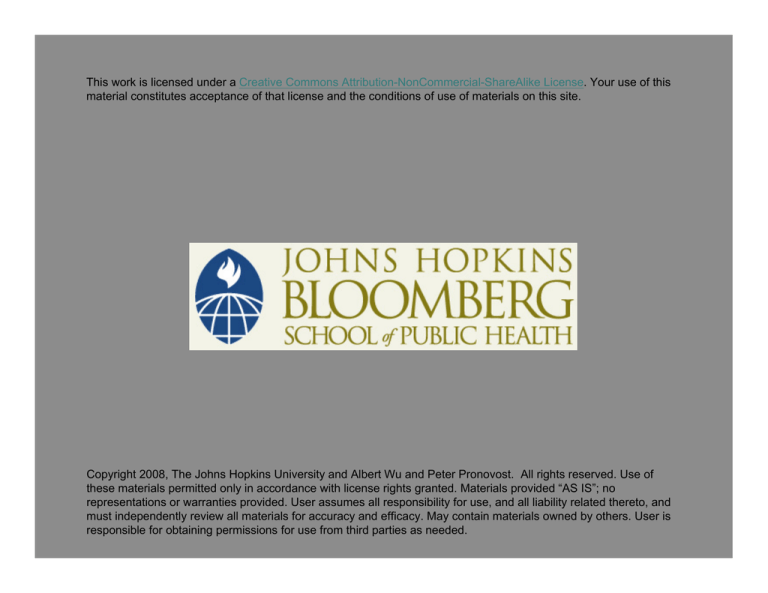
This work is licensed under a Creative Commons Attribution-NonCommercial-ShareAlike License. Your use of this
material constitutes acceptance of that license and the conditions of use of materials on this site.
Copyright 2008, The Johns Hopkins University and Albert Wu and Peter Pronovost. All rights reserved. Use of
these materials permitted only in accordance with license rights granted. Materials provided “AS IS”; no
representations or warranties provided. User assumes all responsibility for use, and all liability related thereto, and
must independently review all materials for accuracy and efficacy. May contain materials owned by others. User is
responsible for obtaining permissions for use from third parties as needed.
The Science of Safety
Albert Wu, MD, MPH
Peter Pronovost, MD, PhD
Johns Hopkins University
Section A
Accident Causation
Quote
“In place were not just one, but a series of safeguards—
some human, some procedural, some technical—that
were supposed to ensure an accident of this nature
could never happen. Yet, quite clearly, these safeguards
failed.”
4
Quote
“In place were not just one, but a series of safeguards—
some human, some procedural, some technical—that
were supposed to ensure an accident of this nature
could never happen. Yet, quite clearly, these safeguards
failed.”
— Gen. John Shalikashvili
Chairman, Joint Chiefs of Staff
Source: Gen. John Shalikashvili in Snook, Scott A. (2000). The accidental shootdown of U.S.
Black Hawks over northern Iraq. Princeton: Princeton University Press.
5
Friendly Fire
On April 14, 1994, two U.S.
Air Force F-15 fighters
accidentally shot down two
U.S. Army Black Hawk
helicopters over Northern
Iraq, killing all twenty-six
peacekeepers onboard.
Image Source: US Army. Photo by US Staff Sgt. Samuel Bendet
6
Bhopal
December 2–3, 1984
Methyl isocyanate leak
8,000 killed
7
Bhopal: Multiple Failures
Recent downsizing and maintenance cutbacks had greatly
increased operator workload and fatigue
Displays did not display historical “trend” data
Operators required to make maintenance and operation
record entries in English
Notes Available
8
Aviation
100 major incidents per year
25–30 “hull losses” per year
Observations show 2 errors per flight = 100 million per year
9
Aviation
100 major incidents per year
25–30 “hull losses” per year
Observations show 2 errors per flight = 100 million per year
Which one of these is the right metric?
10
How Do Accidents Happen?
Photo source: Dave Parker. Creative Commons BY.
11
Individual Approach to Causation
Errors arise primarily from aberrant mental processes, e.g.,
forgetfulness, inattention, poor motivation, carelessness,
negligence, and recklessness
12
Systems Approach to Causation
Basic premise: humans are fallible, errors are expected even in
the best organizations
Causes include traps in the workplace and organizational
processes
Countermeasures are based on the assumption that working
conditions can be changed
13
How Do Accidents Happen?
All complex systems are intrinsically
hazardous—
− Road, rail, and air traffic
− Space missions
− Nuclear reactors
Generally heavily defended against failure
Contain latent errors
Routinely run in degraded modes
Catastrophe requires multiple failures
14
Ideal: Each Defensive Layer Impenetrable
In reality, defenses are like slices of Swiss cheese
Holes continually opening, shutting, shifting
Presence of holes in any one “slice” does not normally cause a
bad outcome
Accidents happen when the holes in many layers
momentarily line up to allow an accident
15
Section B
Human Performance
Paradox
Health care workers generally
− Highly trained
− Conscientious
− Well-meaning
− Use sophisticated treatment
Errors and harm are common
17
Human Performance
Skills
Rules
Knowledge
18
Individuals and System Design
Role of individuals in error causation
Not to point blame
But to help us design systems that take this into account
19
Human Performance
Skills
Rules
Knowledge
20
Skill-Based Errors
You know what you are doing, but your actions don’t go as
planned (slips, lapses, fumbles)
Source: Reason. (2002).
21
Slips (Attention), Lapses (Memory), Fumbles (Execution)
You have a dentist’s appointment but drive to work anyway
“Have a good flight.” “You too.”
You forget your colleague’s name
Coffee misses mouth
22
Rule-Based Errors
You think you know what you are doing, but fail to notice
contraindications, apply a bad rule, or fail to apply a good rule
(rule-based mistakes and/or violations)
Source: Reason. (2002).
23
Rule-Based Errors (If A,Then Do B)
Crossing over the double-yellow line
Ignoring the rule “Any female of child-bearing age is
pregnant”
24
Knowledge-Based Errors
You’re not really sure what you are doing (knowledge-based
mistakes in novel situations)
Source: Reason. (2002).
25
Knowledge-Based Errors
Driving on an unfamiliar road
Is it nerve, artery, vein?
26
Cognitive Biases in Decision Making
Heuristics/cognitive dispositions to respond
27
Cognitive Biases in Decision Making
Availability (recency)—things are more frequent if they come
readily to mind
Visibility bias
Source: Croskerry, P. (2002). Acad Emerg Med, 9, 1184.
28
Cognitive Biases in Clinical Decision Making
Overconfidence
Source: Croskerry, P. (2002). Acad Emerg Med, 9, 1184.
29
Cognitive Biases in Clinical Decision Making
Representativeness—if it looks like a duck . . .
Source: Croskerry, P. (2002). Acad Emerg Med, 9, 1184.
30
Cognitive Biases in Clinical Decision Making
Search satisficing—call off the search once something is
found
Source: Croskerry, P. (2002). Acad Emerg Med, 9, 1184.
31
Summary
Doctors and nurses are human, too
Human error inevitable
32

